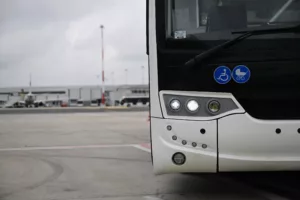Ground support equipment is responsible for moving passengers safely across the apron. However, it often comes with a hidden financial burden: the diesel apron bus. The initial cost of fuel has already been a clear expense, but the actual total cost of ownership for these vehicles includes many overlooked factors that can greatly affect your profit. While the more hidden costs can appear innocuous at first, they can just as quietly drain the budget when adding up over time. By identifying and reducing these various costs, airports and cities can make better financial decisions and move toward a more sustainable future. The hidden costs of a diesel airport fleet are real. They stem from the very specific working conditions of the airfield. Unlike city buses, airport buses travel shorter distances, are often idle, and deal with constant stop-and-go traffic. This challenging cycle can, more often than not, lead to costly mechanical failures.
Over-Paying For Maintenance
One of the biggest hidden costs is excessive maintenance. A major cause is the Diesel Particulate Filter (DPF). The DPF traps soot from exhaust gases, but all of the frequent idling and short trips can prevent the engine from reaching the high temperatures needed to clean out the filter. This cleaning process is called regeneration. When the filter clogs, it can cause the vehicle to shut down, among other issues. The maintenance that’s needed, whether it’s manual cleaning or a complete and total replacement, takes a lot of time and costs quite a bit, with a single replacement costing thousands of dollars. These DPF problems don’t usually just impact one bus; they can create a ripple effect, increasing the overall maintenance burden on your entire fleet and eventually disrupt operations.

Inefficient Refueling
Another less-than-ideal part of bus operations is their general refueling inefficiency. City buses can refuel overnight at a central depot, but apron buses usually require a fuel truck to come to them onsite. Airport-specific buses, especially ones that aren’t certified roadworthy for urban roads, simply can’t be driven to a gas station for an easy top up. Instead, airport fleets need a fuel truck or cart brought onsite to make sure that each bus has enough to finish the trips. This process is inefficient. It takes loads of staff time, can be inefficient, and can lead to safety and logistical issues on a busy apron. These small inefficiencies may not seem like much at a first glance, but they absolutely add up over time. And with plug-in or pantograph charging technology on a rapid rise in innovation, the next step forward for most airports is battery technology.
Unplanned Downtime
Finally, the biggest hidden cost by far can be the unplanned downtime, which can derail fleets at any time. When a diesel standing bus has a DPF-related failure or another such mechanical problem, it affects more than just one vehicle. This disruption can cause delays for passengers, late departures, and a chain reaction that can throw off entire built up schedules. The unreliability of diesel buses in the busy apron environment can hurt the on-time performance metrics that airports and passengers value.
The Next Solution
Say goodbye to most of these diesel-related, sneakier expenses when you switch to an electric airport bus fleet. In all cases, DINOBUS electric bus models are built and designed to handle the busiest of environments, no matter what budget or resources the operators are working with. There is no need to worry about DPFs issuing failures, virtually no tailpipe emissions, and less unforeseen repair bills being added to the cost. With modern day fast charging stations, refueling time can be replaced with a charging time of just under two hours at the most. Everything can run smoother, from routine check-ups to plug-in charging. When taking a complete look at the entire lifespan of a DinoBus, the value speaks for itself, especially when supplemented by incredible ease of use and total client support. Oftentimes, it isn’t just about the environmental responsibility of airports worldwide, though that’s a definite bonus, it’s a strategic move towards future-ready operations. You’re positioning your airport for greater reliability, efficiency, and, at the end of the day, stronger profitability.